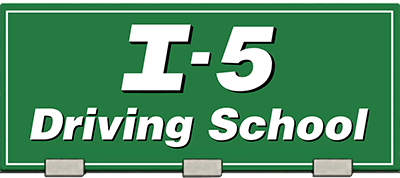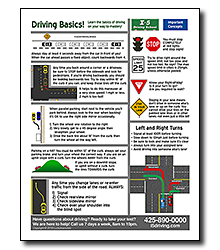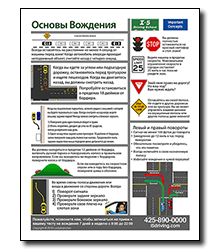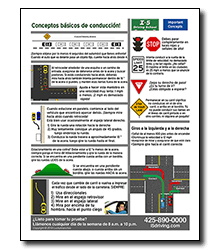Prepare
for the
Driving
Test
How difficult is this test?
While Washington is reported to have the most difficult driving test in the nation, it's really pretty easy. You just have to avoid enough technical errors for about 15 minutes. We've seen very experienced drivers fail the test, while some truly scary drivers have passed.
Why don't you just fail the scary ones?
We aren't permitted to do that. The test is scored fairly simply; if you commit a technical error, the corresponding points are deducted. For example, if you stop ON a stop line (instead of behind it), it's a 2-point penalty. It doesn't matter how experienced you are; the points are still deducted. We aren't allowed to insert our opinion, and it's much fairer that way.
But I've been driving for 30 years!
We get it, and you've probably driven all of those years without a crash. However, most experienced drivers tend to get a little slippery with the rules, such as not stopping completely at a stop sign if no one else is around. Five or 6 miles an hour over the speed limit is probably routine, but on the driving test it isn't.
What should I expect for the driving test?
The driving exam consists of:
- 15-20 minutes of driving
- 5 maneuvers (scroll down for some videos)
- No freeway driving
- The examiner won't try to trick or confuse you
- Best to arrive a few minutes early
What do I need to know to pass?
Over the tens of thousands of driving tests we have offered, our best advice is:
1) Relax. You don't need to drive perfectly. You can lose a lot of points and still pass.
2) Practice the little things. Don't worry about parallel parking so much. It's only worth 4 points, but using your turn signal when you are supposed to is worth 36 points.
3) You might be a great driver, but the test doesn't measure that. It measures your ability to avoid technical errors over a 15-minute period.
Lower down on this page are some helpful videos, and just below this paragraph are some tip sheets. These are all free resources, and very helpful in demystifying what is on the driving test.
Videos
Pre-test
Before we even start moving the car, we'll check your turn signals, brake lights, parking brake, hand signals, and few other things.
There is no scoring on this part of the test; it's just to make sure that the car is safe, and that you know the left, right, and stop/slow down hand signals. You won't use these signals on the test; we just need to know that you recognize them when cyclists use them.
The Backing Maneuver
This is the most difficult maneuver on the driving test. Most test takers do not keep any of their points on this maneuver, but the good news is that there's only 4 points to lose here (you can lose 20 points and still pass).
The most important things to remember are:
1) Look mostly out the rear window
2) Go 1mph or less. Really.
3) Signal, check your mirrors, and over your left shoulder when returning to traffic.
Parallel Parking
The second most-difficult maneuver on the driving test is also not a huge priority. It's only worth 4 points, and you can miss up to 20 points and still pass. This isn't a make-or-break maneuver!
The key to mastering this is to turn around and look out the rear window when driving in reverse. Put your hand at the top of the steering wheel so your brain knows which way to turn the wheel.
Lane changes and turning
You may be thinking, "Yeah I can turn the car and change lanes, whatever". We believe it! However, turning and changing lanes on the test has a handful of technical requirements you'll want to do correctly.
For example, when you are turning left onto a road with more than one lane, you always have to choose the one closest to the one you came from. Did you start your turn while next to the double yellow line? You have to
land in the lane next to the double yellow line. Every time!
Parking on a hill
This helpful video explains how to park on a hill and why you should care. This is one of the maneuvers on the test, and most of us usually forget to set the parking brake.
You should always set your parking brake, as it will save you a lot of money on transmission repairs in the future, in addition to the hill parking benefits.
What do you check on the drive test?
• Proper identification of signs and lights - You must know the meanings of different signs, lights, and pavement markings.
• Proper backing technique - You will be directed to back your vehicle around a corner to the right, staying as close to the edge of the street as you can, and safely continue backing in a straight line until directed to stop.
• Your ability to park on a hill - You will be directed to park your vehicle as if you were going to leave it unattended.
• Parallel parking ability - You will be directed to back into a parking space, either between four poles, two vehicles, or one vehicle with an imaginary vehicle parked about 1 1/2 car lengths to the rear.
• Safe entry into traffic from a stopped position - You will be directed to drive to the edge of the road and stop, then directed to reenter traffic.
• Speed limits - Be aware of the speed limit. Do not exceed the limit, but don’t drive so slowly that you impede others.
What else will I be tested on?
Driving in traffic
- Using the proper lane
- Signaling to change lanes
- Checking your blind spot
- Following other vehicles at a safe distance
- Signaling the proper distance before turning
- Stopping smoothly, completely, and at the right spot
Backing up
- Looking over your right shoulder
- Backing in a straight line
- Maintaining control of your car
- Scanning for pedestrians and other vehicles
Driving through blind or crowded intersections
- Scanning for signs, signals, pedestrians and other vehicles
- Yielding and taking the right-of-way correctly
- Obeying traffic signals, signs, and roadway markings
- Turning into the proper lane without cutting the lane
- Turning without going wide into the improper lane
Good news for drive exam takers; we don't drive on the freeway!




